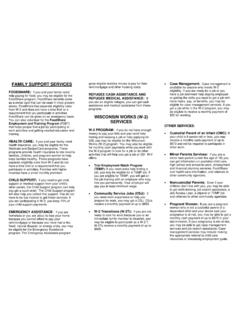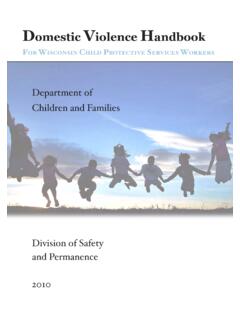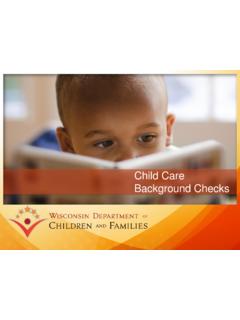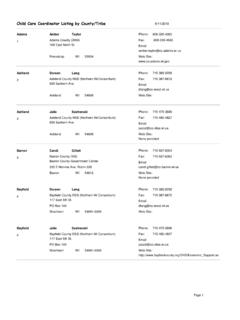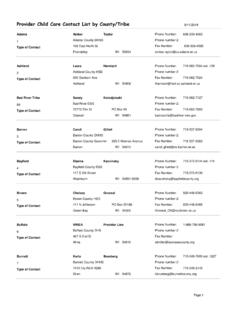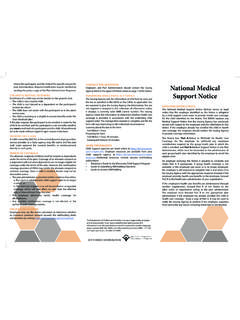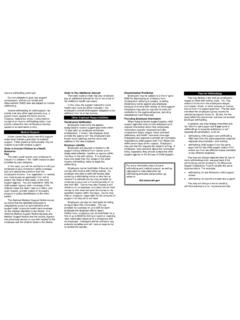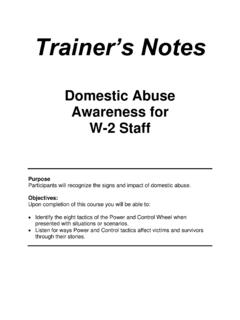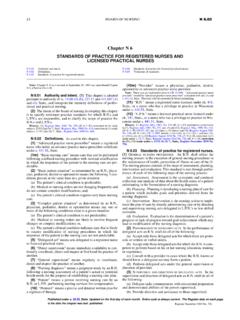Transcription of Structured Analysis Family Evaluation (SAFE ... - Wisconsin
1 1 Structured Analysis Family Evaluation (SAFE) home study Assessment Introduction The SAFE home study assessment is a standardized home study developed by the Consortium for Children. The SAFE home study assists agencies in performing a thorough, Structured , and uniform Evaluation of families who have applied to become foster or adoptive parents. The SAFE home study assists in identifying and addressing both strengths and areas of concern that may impede functioning, as well as parenting. Use of a standardized home study assessment is one of the tools agencies use in documenting the Analysis of the determination as to whether or a not a prospective foster or adoptive home is fit and qualified for caring for children placed in out-of- home care.
2 Consideration must be given to the importance of matching a prospective foster or adoptive home with a child whose needs can be met in that home . The home study determines if a Family is ready, willing, and able to become a suitable and safe placement resource for a child or children using the criteria of safety, permanence, and well-being. In addition to the requirements for completing the SAFE home study assessment, agencies shall also comply with requirements set forth in Ch. DCF 56 Admin. Code, Foster home Care for Children; Ch. DCF 51 Admin. Code, Adoption of Children with Special Needs and Preadoption Preparation Training; and Ch.
3 DCF 54 Admin. Code, Child Placing Agencies, as applicable. Applicability Use of the SAFE home study assessment is required for all foster care licensing in Wisconsin and as the Evaluation to determine the suitability of the home for a child who is the subject of an adoption. The requirement for a standardized home study applies to all public and private adoptions in Wisconsin , whether the child is a or foreign citizen, but does not apply to an adoption by a stepparent for which other screening standards are required under current law. This policy applies to all counties, child placing agencies, and the Division of Milwaukee Child Protective Services (DMCPS) prior to issuing a foster home license or adoption approval.
4 Agencies may only provide home study approval within their statutory authority under s. (1) (hm), Wis. requirements under this policy are contained in boxes. Agencies shall assure that all actions of either the agency or contracted provider staff comply with this policy. 2 Definitions home study Practitioner is the caseworker or licensor who is completing the home study components and writing the home study report for foster care licensure and/or adoption approval, and has also completed the mandatory training requirements. SAFE home study Assessment Components The home study process is broad and goes beyond evaluating Family dynamics.
5 The SAFE home study assessment has three components that shall be utilized when administering the assessment: Information Gathering Tools Structured Analysis Tools Preformatted home study Report SAFE home study practitioners shall utilize these three components when administering the SAFE home study . Each component is described in more detail below. For additional information on the SAFE home study process, review Appendix A, SAFE home study Flow Chart, and Appendix B, SAFE Supervisor Flow Chart. Information Gathering Tools The SAFE home study process utilizes the following information gathering tools to support the SAFE interview with families: SAFE Questionnaire I SAFE Questionnaire II Reference Letters home study Interview home study practitioners are required to administer each of these tools, which are explained further below.
6 SAFE Questionnaire I SAFE Questionnaire I reviews a variety of areas that are related to Family history and functioning. home study practitioners shall administer Questionnaire I using the following guidelines: Provide Questionnaire I to the foster home or adoptive home applicant(s) to complete and return to the agency prior to the first interview. Typically, this will be provided with the foster home or adoptive home application. Questionnaire I shall be administered to each applicant; it may also be administered to other members of the household, if the agency chooses.
7 SAFE home study practitioners shall review the completed Questionnaire I in preparation for the home study interviews. 3 The template for Questionnaire I is available for download on the Consortium for Children s website. The template is only available to individuals who have completed the two-day initial SAFE training. SAFE Questionnaire II SAFE Questionnaire II reviews issues or behaviors amongst the applicant(s). home study practitioners shall administer Questionnaire II using the following guidelines: Questionnaire II shall not be provided or mailed to the applicant(s) ahead of time.
8 Questionnaire II shall never leave the home study practitioner s sight or control. Questionnaire II shall be administered directly by the home study practitioner in a private setting with all applicants present and together. Questionnaire II shall be administered to all applicants; it may also be administered to other members of the household, if the agency chooses. Applicants shall not communicate with each other or the home study practitioner while completing Questionnaire II. home study practitioners shall interview each applicant privately and individually immediately after the administration of Questionnaire II.
9 The SAFE training provides practitioners with resources and information to assist in their interviews. The template for Questionnaire II is available for download on the Consortium for Children s website. The template is only available to individuals who have completed the two-day initial SAFE training. Reference Letters Ch. DCF 56 Admin. Code requires reference letters in accordance to the applicant s level of care certification, which are required as part of the SAFE home study process. References shall be administered for each applicant as required under Ch. DCF 56 Admin.
10 Code. Reference letters shall be mailed to the individuals who will be providing the reference; they shall not be given to the applicant to provide the letter to the individuals. Reference letters shall be returned directly to the agency. The template for the Reference Letter is available for download on the Consortium for Children s website. The template is only available to individuals who have completed the two-day initial SAFE training. Agencies may use the Reference Letter template provided by the Consortium for Children, or they may use their own agency-specific reference letter.
